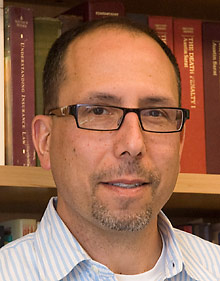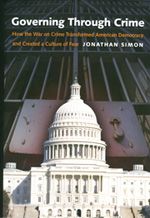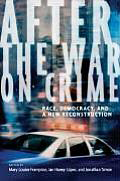Why do we tolerate a massive prison system that produces 70% recidivism rates?
Our 'tough on crime' approach lets both government and criminals 'off the hook,' says legal expert Jonathan Simon
| 07 May 2009
BERKELEY — In Part 1 of this two-part Q&A, UC Berkeley Law Professor Jonathan Simon talked about criminal sentencing and parole as practiced today in California. He concludes here by discussing the social and fiscal impacts of our approach to crime and punishment, the current opportunity for prison reform, and some ideas for meaningful change.
 Jonathan
Simon (NewsCenter photo)
Jonathan
Simon (NewsCenter photo)
Q. California's budget crisis, together with the federal judiciary concern about California prison overcrowding, have focused critical attention on the state's massive penal system. In light of these developments, what are the prospects for meaningful reform?
A. This is a very exciting moment. Two seemingly independent but powerful forces are opening the policy window. One, as you say, is the budget situation: over recent decades, Californians have seen the portion of the state discretionary budget devoted to Corrections grow from below three percent in 1980 to almost 10 percent today. During relatively prosperous times, this high cost was not very visible. But now, with our epic budget deficit requiring service cuts all over the state, the more than $8.5 billion annually that the state spends to maintain its giant adult correctional system is becoming more of a problem.
Simultaneously, we have the Plata-Coleman mega litigation. Five separate lawsuits have clicked together into one monster lawsuit about prison overcrowding, and a three-judge panel has suggested that only a reduction in the population of California prisons can make the constitutional violations remediable. These federal judges issued a preliminary ruling, earlier this year; in it they suggest they will order the state to reduce its prison population by 20,000 to 50,000 (although they probably won't tell the state how it has to achieve that reduction.)
These developments seem to create an enormous opportunity for change. But for how long and to what end? Let's say the judges order California to reduce the prison population by even as many as 30,000 or 40,000. It might be possible to handle that, partly by sending California prisoners to private prisons in other states. (It might require changing the law — but that could be done.) And surely there would be an effort to keep some parolees from going back to prison, for at least awhile, to comply with the court's ruling.
But my fear is that in the next boom cycle (which we tend to have in California), the basic lie that underlies our system — that the status quo, our current penal process, is making us safer — will remain the powerful force it has been in California politics. And as a result, 10, 15 years from now we'll have a bigger prison system than ever, maybe some of it located in Mexico or Arizona or someplace where it's cheaper to run prisons.
Unless we confront this basic story/promise/lie that's been sold so effectively to Californians over the last three decades, everything is rearranging deck chairs on the Titanic. We're still stuck with this colossal penal system that is starving us fiscally, when there are all these other things we need to fund.
Q. Is racism a strong driver behind the 'ruling through crime' mentality?
A. Yes. Some would say "Look, the civil rights movement broke down a traditional system of racial domination associated with Jim Crow in the South and with ghetto police enforcement in the North. And mass imprisonment, governing through crime, became replacement tools, basically, to maintain a racially unequal and separate society. I think there's a lot to that argument.
But what has also developed in our society is a mandate for crime control that clearly has won a huge constituency, across racial and ideological divides. Think of the federal sentencing guidelines for crack vs. powder cocaine — where you have to possess 500 grams of powder cocaine, but only five grams for crack cocaine, to get a mandatory minimum sentence of five years. Today this is exhibit #1 in many people's minds of racial bias in our justice system — since crack cocaine is overwhelmingly associated with black users and sellers, while powder cocaine remains associated with rock stars, investment bankers, and white users generally. Yet the entire Congressional Black Caucus supported the five-gram limit for crack cocaine. The scourge of crack was hurting black neighborhoods, and tough crime laws seemed to be the way the government could respond.
Q. What criminal-justice reforms would you like to see in California?
A. The most important thing we can do is use the penal code to set firmer limits on who can be sent to prison, as opposed to being dealt with through jail or probation at the county level. Currently our law gives county-level prosecutors huge discretion to select charges that will send local criminals to state prison, where the state pays all of the costs of incarceration. This has the terrible result of producing an ever-growing state prison population and an ever-growing group of people who, having been in a California prison, are deemed permanently dangerous.
Prison should be reserved for those who pose such a threat of violence that they cannot reasonably be worked with in the community. We should actively subsidize counties (as we did in the 1970s) to keep more of their offenders in the county system — where they can remain better integrated into the families and community resources they will eventually need to engage with in order to stay crime free.
Beyond that, we need to revamp some of the institutions that are routinely directing people into the criminal-justice system. This is especially true of our schools, which have become gateways to criminal-justice custody through disciplinary regimes and test-based pressures to force out weaker students. Another example is our mental health system, which has been allowed to atrophy, leaving many of the untreated mentally ill on a pathway toward criminalization and incarceration. A renewed and reformed mental health system could reduce both violence and mass imprisonment in the United States.
The book I co-edited with two Berkeley colleagues, (After the War on Crime: Race, Democracy, and a New Reconstruction), elaborates on ways we could move forward from our war-on-crime approach.
Q. Talk about your blog and what you're trying to accomplish with it.
A. Many people think that after 9/11 the war on terror became the vehicle for transforming how America was governed. But in Governing Through Crime (subtitled How the War on Crime Transformed American Democracy and Created a Culture of Fear) I argue that the war on terror has been an extension of the war on crime, which had already transformed American democracy along all the same lines. I try to show the ways in which American government, and even civil society, have been transformed and distorted by the war on crime, how the overcrowded prison is just one manifestation of this larger way of organizing our democracy.
So in my blog I keep a critical eye on the daily news and events, using the framework of "governing through crime" — this awareness that we have become trapped in ways of thinking and responding, ever since the late '60s — to help illuminate the public dialogue.
One of my real complaints is that when we govern through crime, we sound tough, but we're really giving everybody a break, especially government. When we say that we want government to be tough on crime, we mean that we want prison sentences to be long and the rhetoric to be sharp. But we don't actually hold government accountable for reducing crime. If we did, we wouldn't put up with prisons that produce 70 percent recidivism rates. We would long ago have said "Why are we building and supporting these prisons if they're failing most of the time?" Instead we've been satisfied with the rhetoric of toughness, and an emotional appeal to solidarity with the victim and disparaging disdain for the offender. We've taken government off the hook.
Likewise, when we lock people up in prison, we're really letting them off the hook as well. I have a friend, an activist for mothers and children of inmates, who basically argues that when you send a man to prison, he doesn't have to take care of his kids, he doesn't have to work, he doesn't have to worry about the elderly in his community. You're creating an adolescent fantasy for him, where he's going to get strong, do bad stuff, and basically hang out with the boys. Someone's going to feed him every day, do his laundry. It's anything but responsibility.
I don't expect President Obama to directly confront crime issues, because he's so politically pragmatic. But one of the things that excites me about Obama is when he talks about a new accountability for government. In doing that, he may start weaning us of this habit of letting government off the hook. If people start demanding to know what they're actually getting for our public investments in crime repression, I think the war on crime will become less popular.
See Q&A part 1: From sentencing to post-release parole, our criminal-justice system is 'broken,' says legal scholar Jonathan Simon



